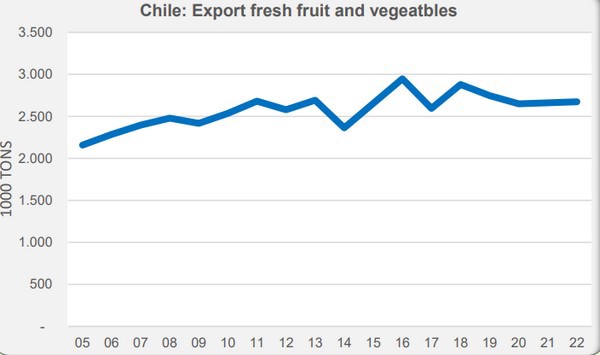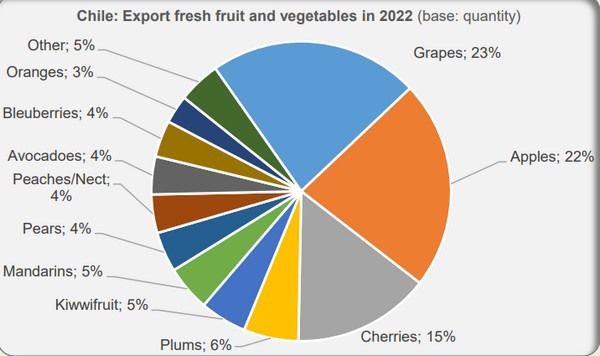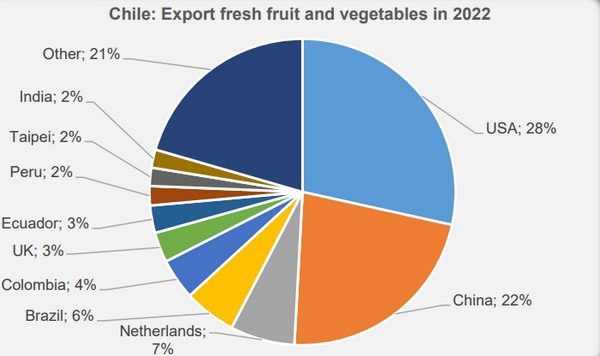In 2022, Chile exported 2.67 million tons of fresh fruit and vegetables, nearly as much as the previous two years. In the past decade, those exports ranged from 2.36 to 2.95 million tons. In recent years, however, there has been a clear shift regarding customers.
North America is still the most important sales region, but those exports are not nearly as large as before. And fewer and fewer Chilean fruits and vegetables go to the EU. South America and Southeast Asia, especially China, are emerging markets for Chilean produce.

The U.S.A. was the top buyer in 2022, with 760,000 tons of exports. China is number two with 600,000 tons. The Netherlands follows at 183,000 tons. Then it is Brazil and Columbia at 147,000 and 116,000 tons, respectively, and the United Kingdom at 85,000 tons.
Grapes oust apples are top export product
Last year, grapes were Chile's most important export product. That is after apples were number one in previous years. Grape exports rebounded sharply after a dip in 2021. Over 600,000 tons of grapes were exported in 2022.
That was, however, less than the years before 2021. The United States is by far the most important market for Chilean grapes. In 2022, Chile exported a whopping 310,000 tons of grapes there. China was second with 78,000 tons, and the Netherlands followed with 45,000 tons.
Ever-increasing volume of cherries exported, especially to China
Cherries, too, have become a big export product for Chile. Last year, that country exported almost 400,000 tons, 20% more than in 2021. Previous years' growth is even more substantial. Chilean cherry exports rely almost entirely on sales to the Chinese market.

Plums are the fourth top export product, but at 160,000 tons, far less of these are exported than the three largest product groups. Here too, China is an important market, taking nearly 100,000 tons of Chilean plums last year. That was (much) more than before. The U.S. and Brazil are the other major buyers. Chilean plum exports to Europe are limited.
Chilean kiwi exports are also declining. In 2022, 135,000 tons were exported. In 2018, that was still 180,000 tons. The United States is the primary market, followed by Brazil, India, and the Netherlands.
Ever-fewer pears too
In 2022, Chile again exported fewer mandarins: 131,000 tons versus the previous 150,000-200,000 tons. Almost all went to the United States. Orange exports show a similar picture: less each year and almost all to the United States.
Chile is also exporting fewer pears, totaling 116,000 tons in 2022. Columbia, the Netherlands, Italy, and Ecuador are the main buyers. Chilean peach exports are holding up reasonably well, reaching 111,000 tons last year. China and the United States account for nearly two-thirds of that, with modest exports to Europe. To the Netherlands, for example, 6,000 tons were exported last year.
Growing blueberry market does not benefit Chile
Avocado exports from Chile vary somewhat, from less than 100,000 tons in 2020 and 2021 to 145,000 tons in 2019. Last year, that was 110,000 tons, with the Netherlands taking 41,500 tons. That makes it the top buyer, followed by Argentina (17,000 tons) and the U.K. (14,000 tons).
Chile fails to benefit from the globally growing blueberry demand. Those exports have been on a downward trend recently, reaching 105,000 tons last year. Most Chilean blueberries - 50,000+ tons - go to the United States. In 2022, the Netherlands was the second-largest buyer, at 24,000 tons, but exports to that country are on the rise. The United Kingdom, China, Germany, and Korea follow at some distance.

Less and less to the Netherlands
The Netherlands has, for many years, been trailing the U.S.A. and China as the third-largest destination for Chilean fruit and vegetables. However, exports to the Netherlands are declining. Between 2010-2015, that involved an annual amount of about 250,000 tons. In 2020 that was just under 200,000 tons, but in the past year, it was 183,000 tons.
At 45,000 and 41,500 tons, respectively, grapes and avocados are currently the top products going to the Netherlands. Just a few years ago, Chile exported almost 60,000 tons of apples to the Netherlands; last year, that was 34,000 tons.
Blueberry exports to the Netherlands did grow, reaching 23,600 tons. Chilean pear exports to the Netherlands fluctuate somewhat. After a dip in 2020 and 2021 (12,500 tons), that rebounded to 15,000 tons last year. But, the Netherlands is taking fewer Chilean kiwis. That fell to 10,000 tons in 2022.
Chile still sends reasonable quantities of peaches (6,000 tons) and plums (3,000 tons) to the Netherlands. In 2022, cherry exports to the Netherlands grew sharply, but at 1,600 tons are modest. Lemon exports fell from 5,000 to less than 1,000 tons. Other than that, only the 800 tons of onions exports are of any significance.
Click here for the background figures
For more information:
Jan Kees Boon
Fruit and Vegetable Facts
Website: www.fruitandvegetablefacts.com
Email: fruitvegfacts@gmail.com
